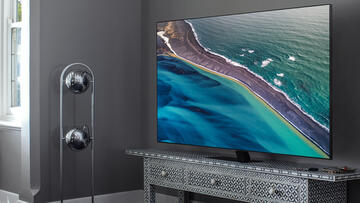Should you buy a 65-inch TV? The short answer is: if you can afford it, a bigger TV is often a better TV. In the UK, the average screen size grew from around the size of a 32-inch TV at the turn of the century up to that of a 40-inch TV by 2010. As 2019 became 2020, the average size of the new TVs sold in the UK was almost 50 inches. Who knows what that will mean the most popular size of 2021 will be by the end of the year.
As you might expect, economies of scale mean that the more popular a certain screen size is, the more affordable (in relative terms) it becomes. You only need to check out the price of one of our favourite 50-inch TVs of 2020, the outstanding Panasonic TX-50HX800, to see what’s what.
When we reviewed the HX800 in June of last year, the 50-inch version cost £899 (around $1,200 / AU$1,650) – and it’s now routinely available for £699 (around $950 / AU$1,270) or so. Compare this to the 40-inch version of the same television: £649 at launch, on sale now for around £599. If a much bigger screen is so relatively inexpensive, why would you choose the smaller one?
Today’s best 65-inch TV deals
A big screen doesn’t mean a big budget
The temptation when buying a new TV is to get the biggest one that’s available within your budget. The average customer upgrades their TV once every six or seven years – so the last thing you want is to get home and be struck by small-screen buyer’s remorse, right? So if your budget will stretch to a 65-inch 4K TV, why not?
It’s not like there aren’t quite a few worthwhile 65-inch TVs around, too, and for a range of prices. If you’re absolutely determined to future-proof your new TV as much as possible, of course, then you’re looking at an 8K resolution Samsung TV – the QE65Q950T will set you back the thick end of £6,000 / $8,000 – or you might consider the less well-specified QE65Q800T alternative for about half of that amount. For the rest of us, though, there’s plenty of choice where the more real-world 4K resolution is concerned.
Our current favourite is LG’s stunning CX OLED – for a fraction under £2,000 ($1,799 / £1,799 / around AU$2,700) you can be the proud owner of a super-slim, high-performance OLED TV with support for both Dolby Atmos and Dolby Vision, and HDMI 2.1 compatibility for your shiny new PS5 or Xbox Series X.
But you shouldn’t overlook Sony’s almost-as-impressive A8H OLED. It’s a little more affordable, enjoys typically Sony picture quality and has a fearsomely clever audio system that uses the entirety of its great big screen to produce sound.
Of course, you don’t have to go deep into four figures to treat yourself to a nice new telly. Hisense’s admirable 65U7QF may not be as accomplished a performer as the alternatives from LG, Samsung, Sony and all the rest – but it’s yours for less than £800 / $1000. Quite a bit less, if you shop around – which is a value proposition that’s hard to argue with.
Sizing up your space
Just because you can afford a 65-inch TV, though, it doesn’t automatically follow that you should go straight out and buy one. There are factors to consider before you get out your credit card and start folding the back seats of your car down.
The most fundamental question of all is: do you have the necessary space to accommodate a 65-inch TV? We don’t mean the surface to put it on, or the wall to hang it on, either – we mean the distance from which you’ll need to sit in order to enjoy a comfortable viewing experience.
We’ve all been to the cinema to see a popular film during its first few days of release, which means at some point we’ve all ended up sitting too close to the screen. It’s rotten, isn’t it? Can’t take in the whole screen at once, can’t help but notice noise in the picture, can’t help but be made to feel a bit queasy by rapid or unpredictable on-screen motion. Well, it’ll be just the same if you’re sitting too close to your TV.
First of all, bear in mind that TV screen sizes are measured on the diagonal. So the ‘65-inch’ measurement indicates the distance from the bottom-left corner of the screen to the top-right corner. This is especially relevant if you plan to mount your TV on the wall – in purely decorative terms it might look great above the fireplace, but unless you watch TV from a bar-stool it’s almost certain to be too high to view comfortably.
That means you need to measure the distance between where the TV is going to be and where you intend to sit when watching it.
4K resolution screens are easier to watch from a short distance than 1080p Full HD equivalents – thanks to the massive uptick in pixel quantity – but nevertheless you don’t want to be too close. A good rule of thumb for 4K screens is to consider a distance of somewhere between 1.5 and 2 times the screen size as the minimum viewing distance. That means you need to be sitting no closer than 2.5m to your new 65-inch television – and, ideally, more like 3 to 3.5m.
Sit too close and you won’t be watching your TV screen so much as watching the pixels that make up the picture. So if you can’t get the sort of distance from your screen that we recommend, well, you’re better off facing the facts and selecting a slightly more modest television.
The biggest benefits for a 65-inch TV
But if you can put sufficient distance between yourself and the screen, you’re good to go. But just because you can accommodate a 65-inch TV, does it automatically follow that you should? What tangible benefits are there to a big 65-inch television, anyway?
Well, at the risk of stating the obvious, a bigger screen means a bigger image. That, in turn, means a more immersive, intense and life-like viewing experience – particularly if your new screen is equipped to take advantage of cutting-edge technologies like dynamic metadata HDR. If you’re paying top dollar for a 4K Netflix subscription, or you’ve got a 4K Blu-ray player for a truly premium picture, those extra inches will translate directly into a more vivid and cinematic watch.
And if you give your money to Philips for a 65-inch version of one of its Ambilight-equipped OLED TVs (the 65OLED935+ is a truly outstanding TV, and – thanks to Bowers & Wilkins – for once it’s a screen with audio quality to match up to the picture quality), the effect of those rear-facing LEDs beaming light onto the wall behind the screen is even more pronounced than it is on the smaller variants.
Gamers, too, will enjoy those extra screen inches. As long as you make sure your new 65-inch TV is equipped with HDMI 2.1 – which rules out the Philips TV, but most definitely rules in the likes of Samsung’s outstanding QE65Q95T QLED screen – every next-gen console feature can be accommodated. The likes of variable refresh rate, 4K/120Hz passthrough and HGiG HDR tone-mapping only add to the already thrilling visual experience served up by both the Xbox Series X and Playstation 5 – and here, too, a big screen really allows you to be drawn into the action.
In short, then, there’s no reason not to think long and hard about a 65-inch TV when you’re researching your new TV – provided you have the space to get a realistic distance away from it, at least.
Today’s best 65-inch TV deals



